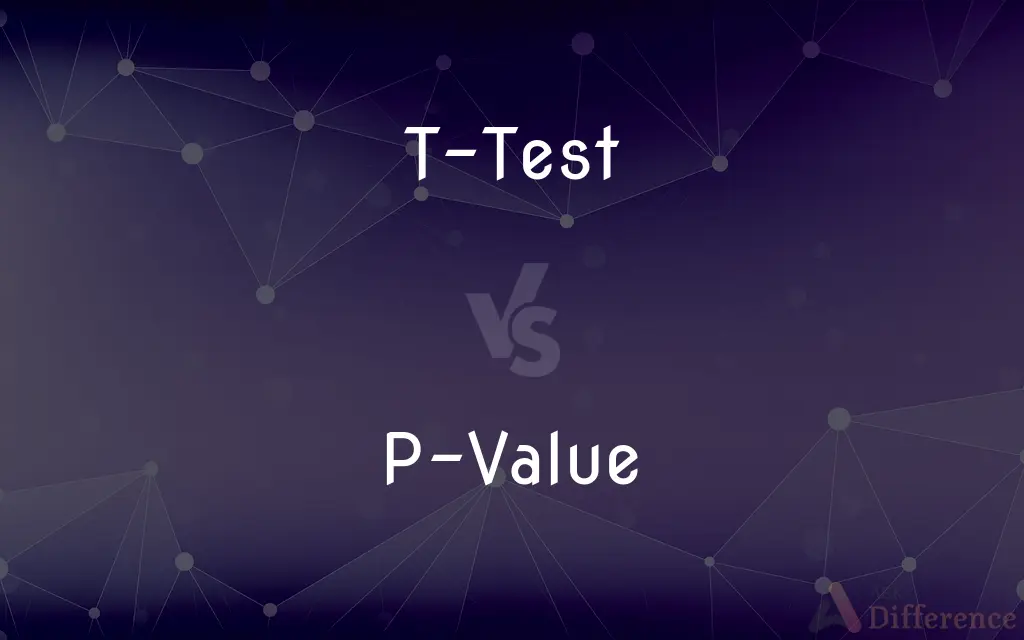T-Test vs. P-Value — What's the Difference?
Edited by Tayyaba Rehman — By Fiza Rafique — Published on December 6, 2023
The T-Test is a statistical test assessing the difference between means; the P-Value quantifies the evidence against a specified null hypothesis.

Difference Between T-Test and P-Value
Table of Contents
ADVERTISEMENT
Key Differences
In statistics, the T-Test is a widely employed tool. It's used to determine whether there's a significant difference between the means of two groups. It's a parametric test and is often applied when comparing the average of two groups to infer if they stem from the same population. On the other hand, the P-Value is a measure that helps in interpreting the results of statistical tests, including the T-Test. It provides a metric for the strength of evidence against the null hypothesis.
The T-Test, when conducted, results in a t-statistic. This statistic tells us how much the sample means deviate from each other in units of standard error. The P-Value, in contrast, takes this t-statistic (or other test statistics) and translates it into a probability. This probability reflects the likelihood of observing the data, or something more extreme, if the null hypothesis were true.
While the T-Test is a procedure or method, the P-Value is a result from this (or other) statistical tests. The T-Test is specifically geared towards comparing means, but the P-Value is more versatile. It can be obtained from various statistical tests, not just the T-Test. The main role of the P-Value is to guide the decision on the null hypothesis.
In practice, when using the T-Test, a researcher will compare the P-Value to a predetermined significance level (often 0.05). If the P-Value is less than this level, the result is deemed statistically significant, and the researcher may reject the null hypothesis. In essence, while the T-Test is the method of testing, the P-Value is the tool used to interpret the result of the T-Test.
Comparison Chart
Definition
A statistical test for comparing means.
A measure of evidence against the null hypothesis.
ADVERTISEMENT
Nature
Procedure or method.
Result or outcome of a test.
Applicability
Used for assessing differences between two group means.
Used in various statistical tests, not just T-Test.
Resulting Metric
Produces a t-statistic.
Produces a probability.
Role
Determines if means are statistically different.
Helps decide if a result is statistically significant.
Compare with Definitions
T-Test
A parametric procedure comparing two sample averages.
The T-Test results suggest the new drug is more effective.
P-Value
An outcome determining statistical significance.
With a P-Value below 0.05, the results are statistically significant.
T-Test
A test assessing if two groups' means differ significantly.
We used a T-Test to compare the average scores of two student groups.
P-Value
A measure reflecting data likelihood under the null hypothesis.
The P-Value suggests our findings are unlikely under the null hypothesis.
T-Test
A method for testing hypotheses about population means.
The T-Test showed the training had a significant impact.
P-Value
A metric interpreting statistical test outcomes.
The low P-Value indicates the data isn't due to random chance.
T-Test
A tool to evaluate the difference in means relative to variability.
Using a T-Test, we found no difference in monthly sales.
P-Value
A probability measuring evidence against the null hypothesis.
A P-Value of 0.03 suggests significant evidence against the null.
T-Test
A statistical test for equal means in two samples.
A T-Test confirmed the two machines perform similarly.
P-Value
A value guiding the decision on hypothesis testing.
Given the high P-Value, we failed to reject the null hypothesis.
T-Test
(statistics) Student's t-test
P-Value
(statistics) In statistical significance testing, the probability of obtaining a test statistic at least as extreme as the one that was actually observed, assuming that the null hypothesis is true.
Common Curiosities
What does the T-Test compare?
The T-Test compares the means of two groups.
What is a common threshold for P-Value significance?
A common threshold is 0.05, but it can vary based on the study.
Can you get a P-Value from a T-Test?
Yes, a P-Value can be derived from the results of a T-Test.
What does a low P-Value indicate?
A low P-Value indicates strong evidence against the null hypothesis.
Is a T-Test only for two groups?
A basic T-Test is for two groups, but there are variations for more groups.
Does a T-Test assume normally distributed data?
Yes, a T-Test assumes the data is approximately normally distributed.
What does the t-statistic from a T-Test represent?
It represents the difference between groups in terms of standard errors.
How does sample size affect the T-Test?
Larger sample sizes can make the T-Test more sensitive to small differences.
Can a significant T-Test result be insignificant in real-world terms?
Yes, statistical significance doesn't always translate to practical significance.
Can a P-Value determine the practical importance of a finding?
No, P-Value indicates statistical significance, not practical importance.
When is the paired T-Test used?
When comparing two related groups, like before and after a treatment.
Is a smaller P-Value always better?
Not necessarily; a small P-Value suggests significance, but context and effect size also matter.
What's the relationship between T-Test results and P-Value?
The T-Test gives a t-statistic, which is used to derive the P-Value.
Can P-Values be used outside of the T-Test?
Yes, P-Values can be derived from various statistical tests, not just the T-Test.
What does a P-Value of 1 mean?
A P-Value of 1 suggests no evidence against the null hypothesis.
Share Your Discovery

Previous Comparison
Pronoun vs. Proper Noun
Next Comparison
Royal Blue vs. Navy BlueAuthor Spotlight
Written by
Fiza RafiqueFiza Rafique is a skilled content writer at AskDifference.com, where she meticulously refines and enhances written pieces. Drawing from her vast editorial expertise, Fiza ensures clarity, accuracy, and precision in every article. Passionate about language, she continually seeks to elevate the quality of content for readers worldwide.
Edited by
Tayyaba RehmanTayyaba Rehman is a distinguished writer, currently serving as a primary contributor to askdifference.com. As a researcher in semantics and etymology, Tayyaba's passion for the complexity of languages and their distinctions has found a perfect home on the platform. Tayyaba delves into the intricacies of language, distinguishing between commonly confused words and phrases, thereby providing clarity for readers worldwide.












































